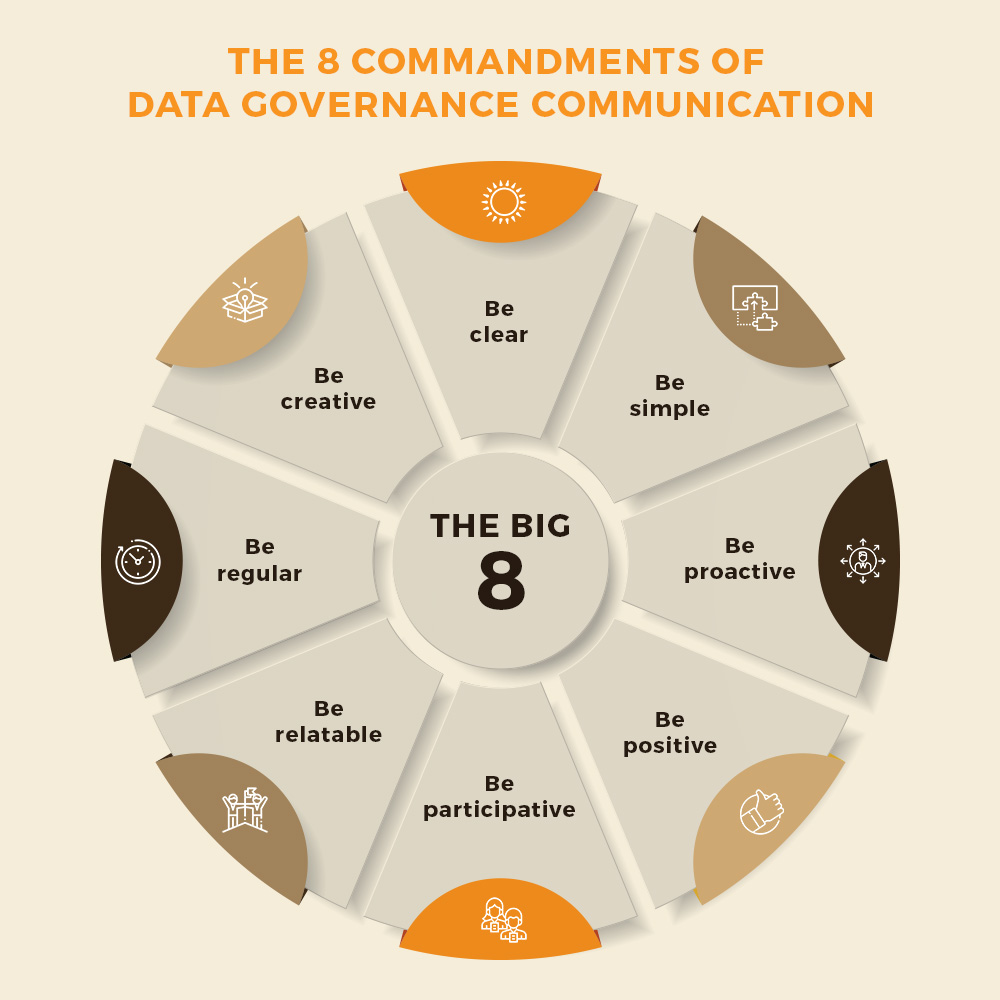
In the modern organization, data governance is not just a function left to technology infrastructure teams. Many questions crop up when DG programs are introduced or fine-tuned. These questions stem from a mix of fear, insecurity and, in most cases, just sheer uncertainty. A clear communication plan is a must to ensure that the Data Governance program goes the distance. Read this blog to know the 8 commandments of data governance communication.

"The single biggest problem in communication is the illusion that it has taken place." - George Bernard Shaw, Irish playwright
In the modern organization, data governance is not just a function left to technology infrastructure teams. With data underpinning almost every function in an office, the DG program must be shared and understood across the organization for it to be truly effective. Organizations that have gone to the trouble of putting in place a solid DG program must remember to go the distance and ensure that it is supported by a transparent, even exhaustive communication plan.
Why is data governance communication important?
There are many reasons for the communication of data governance and its importance, some of which you might certainly be familiar with. Of course, the easiest answer is that a company built on the values of transparency and honesty – as most organizations aspire to – must, by definition, be open with its employees on something as vital to its daily functioning as data and its governance. But that is over-simplifying the case.
To eliminate the fear of change
As mentioned in an earlier post, one of the biggest DG challenges CIOs face is in ‘Getting people throughout the business to understand that it is their responsibility and that it will be beneficial for them in the longer run.’ Most people fear change for the uncertainty it brings. Change in an organization rewrites interpersonal equations, relationships, relevance. As a result, any effort to rewrite the status quo is met with suspicion, insecurity and resistance.
“I had access to this data until now. Why am I suddenly being blocked?”
“I need that information to complete my work. I cannot wait for someone else to pull it out for me every time!”
“How come he gets to have access to this data while I don’t?”
“Are you firing me? Is that why you’ve withdrawn my credentials?”
“I’ve worked for this company all these years, but now, suddenly, you don’t trust me?”
“You have given X access to this data but not to me. Does this mean she is more important than me?”
These are, but just a few of the questions that are asked when DG programs are introduced or fine-tuned. These questions stem from a mix of fear, insecurity and, in most cases, just sheer uncertainty. Organizations that adopt a need-to-know basis when it comes to explaining their DG shifts will often end up having to answer such difficult questions. It becomes an extremely touchy subject for people who are part of such conversations.
To bring the organization together for DG
On the other hand, organizations that are upfront with their employees when instituting a DG policy might find the waters more amenable to smooth sailing. A clear, well-planned communication strategy can even turn the situation on its head, boosting employee morale with the right messaging and confidence-building safeguards.
While the importance of communication is unarguable, how exactly does one go about building such a communication plan? The answer, funnily enough, lies in the simplest truth of all – the same way organizations should ideally communicate everything else of note.

The 8 commandments of data governance communication:
- Be clear: Avoid ambiguous terms when spelling out your policy
- Be simple: Avoid using acronyms or industry terms that require a wealth of experience to understand
- Be proactive: Don’t wait until the DG program is already in place; instead, solicit inputs during the formulation phase so that course corrections can be made in time
- Be positive: Stress on the benefits of the new DG program for the organization as a whole and, if possible, at individual levels.
- Be participative: Enroll as many champions of the new DG direction as possible from outside the steering committee – this will ensure greater buy-in from the rest of the organization as they will no longer feel imposed upon. You can also solicit feedback from relevant stakeholders: their inputs could help you revise the DG plan and perhaps even the way you’re communicating
- Be relatable: Help people understand how the new DG plan is going to make their lives different but for the better. Outline specific examples related to their work and goals and answer their concerns/questions about how life will change post this
- Be regular: Keep sharing updates on the DG plan, its formulation and rollout, modifications, successes and failures
- Be creative: Employ multiple channels to reach out to stakeholders within and without the organization, but remember to always be in control of the manner of messaging
Of course, the decisions need to be data-driven because opinions are good, but data is better.
Remember, your DG program’s effectiveness depends on your approach right from building it to the way it is propagated throughout your organization. And what stands between success and failure?
The way you earn your peers’ buy-in.
Want to know more about setting up a Data Governance communication plan? Reach out to our consultants.


